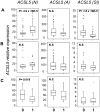High ACSL5 transcript levels associate with systemic lupus erythematosus and apoptosis in Jurkat T lymphocytes and peripheral blood cells
- PMID: 22163040
- PMCID: PMC3232234
- DOI: 10.1371/journal.pone.0028591
High ACSL5 transcript levels associate with systemic lupus erythematosus and apoptosis in Jurkat T lymphocytes and peripheral blood cells
Abstract
Background: Systemic lupus erythematosus (SLE) is a prototypical autoimmune disease in which increased apoptosis and decreased apoptotic cells removal has been described as most relevant in the pathogenesis. Long-chain acyl-coenzyme A synthetases (ACSLs) have been involved in the immunological dysfunction of mouse models of lupus-like autoimmunity and apoptosis in different in vitro cell systems. The aim of this work was to assess among the ACSL isoforms the involvement of ACSL2, ACSL4 and ACSL5 in SLE pathogenesis.
Findings: With this end, we determined the ACSL2, ACSL4 and ACSL5 transcript levels in peripheral blood mononuclear cells (PBMCs) of 45 SLE patients and 49 healthy controls by quantitative real time-PCR (q-PCR). We found that patients with SLE had higher ACSL5 transcript levels than healthy controls [median (range), healthy controls = 16.5 (12.3-18.0) vs. SLE = 26.5 (17.8-41.7), P = 3.9×10 E-5] but no differences were found for ACSL2 and ACSL4. In in vitro experiments, ACSL5 mRNA expression was greatly increased when inducing apoptosis in Jurkat T cells and PBMCs by Phorbol-Myristate-Acetate plus Ionomycin (PMA+Io). On the other hand, short interference RNA (siRNA)-mediated silencing of ACSL5 decreased induced apoptosis in Jurkat T cells up to the control levels as well as decreased mRNA expression of FAS, FASLG and TNF.
Conclusions: These findings indicate that ACSL5 may play a role in the apoptosis that takes place in SLE. Our results point to ACSL5 as a potential novel functional marker of pathogenesis and a possible therapeutic target in SLE.
Conflict of interest statement
Figures




Similar articles
-
In vitro apoptosis and expression of apoptosis-related molecules in lymphocytes from patients with systemic lupus erythematosus and other autoimmune diseases.Arthritis Rheum. 1997 Feb;40(2):306-17. doi: 10.1002/art.1780400216. Arthritis Rheum. 1997. PMID: 9041943
-
TRAIL mRNA expression in peripheral blood mononuclear cells of Egyptian SLE patients.Gene. 2013 Sep 15;527(1):211-4. doi: 10.1016/j.gene.2013.05.084. Epub 2013 Jun 18. Gene. 2013. PMID: 23792015
-
mRNA expression analysis confirms CD44 splicing impairment in systemic lupus erythematosus patients.Lupus. 2021 Jun;30(7):1086-1093. doi: 10.1177/09612033211004725. Epub 2021 Apr 1. Lupus. 2021. PMID: 33794704
-
Inhibition of Fas/Fas ligand-mediated apoptotic cell death of lymphocytes in vitro by circulating anti-Fas ligand autoantibodies in patients with systemic lupus erythematosus.Arthritis Rheum. 1998 Feb;41(2):344-53. doi: 10.1002/1529-0131(199802)41:2<344::AID-ART19>3.0.CO;2-J. Arthritis Rheum. 1998. PMID: 9485093 Review.
-
ACSL family: The regulatory mechanisms and therapeutic implications in cancer.Eur J Pharmacol. 2021 Oct 15;909:174397. doi: 10.1016/j.ejphar.2021.174397. Epub 2021 Jul 29. Eur J Pharmacol. 2021. PMID: 34332918 Review.
Cited by
-
Long-chain acyl-CoA synthetase in fatty acid metabolism involved in liver and other diseases: an update.World J Gastroenterol. 2015 Mar 28;21(12):3492-8. doi: 10.3748/wjg.v21.i12.3492. World J Gastroenterol. 2015. PMID: 25834313 Free PMC article. Review.
-
Effects of interleukin-23 on the activation of mucosal-associated invariant T cells from oral lichen planus.J Int Med Res. 2023 Jun;51(6):3000605231180039. doi: 10.1177/03000605231180039. J Int Med Res. 2023. PMID: 37340721 Free PMC article.
-
PMA and ionomycin induce glioblastoma cell death: activation-induced cell-death-like phenomena occur in glioma cells.PLoS One. 2013 Oct 9;8(10):e76717. doi: 10.1371/journal.pone.0076717. eCollection 2013. PLoS One. 2013. PMID: 24130787 Free PMC article.
-
Acyl-CoA Synthetase 5 Promotes the Growth and Invasion of Colorectal Cancer Cells.Can J Gastroenterol Hepatol. 2017;2017:7615736. doi: 10.1155/2017/7615736. Epub 2017 Jul 20. Can J Gastroenterol Hepatol. 2017. PMID: 28808653 Free PMC article.
-
Fus1/Tusc2 is a novel regulator of mitochondrial calcium handling, Ca2+-coupled mitochondrial processes, and Ca2+-dependent NFAT and NF-κB pathways in CD4+ T cells.Antioxid Redox Signal. 2014 Apr 1;20(10):1533-47. doi: 10.1089/ars.2013.5437. Epub 2014 Feb 4. Antioxid Redox Signal. 2014. PMID: 24328503 Free PMC article.
References
-
- D'Cruz DP, Khamashta MA, Hughes GR. Systemic lupus erythematosus. Lancet. 2007;369:587–96. - PubMed
-
- Herrmann M, Voll RE, Zoller OM, Hagenhofer M, Ponner BB, et al. Impaired phagocytosis of apoptotic cell material by monocyte-derived macrophages from patients with systemic lupus erythematosus. Arthritis Rheum. 1998;41:1241–50. - PubMed
-
- Vermes I, Haanen C, Richel DJ, Schaafsma MR, Kalsbeek-Batenburg E, et al. Apoptosis and secondary necrosis of lymphocytes in culture. Acta Haematol. 1997;98:8–13. - PubMed
-
- Dhir V, Singh AP, Aggarwal A, Naik S, Misra R. Increased T-lymphocyte apoptosis in lupus correlates with disease activity and may be responsible for reduced T-cell frequency: a cross-sectional and longitudinal study. Lupus. 2009;18:785–91. - PubMed
-
- Mevorach D. Systemic lupus erythematosus and apoptosis: a question of balance. Clin Rev Immunol. 2003;25:49–60. - PubMed
Publication types
MeSH terms
Substances
LinkOut - more resources
Full Text Sources
Other Literature Sources
Medical
Research Materials
Miscellaneous

